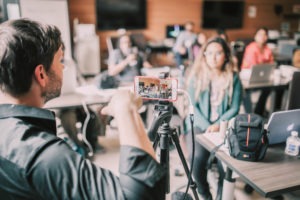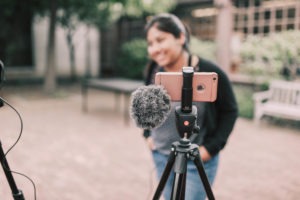Rise Up Be Heard Fellowship
The UC Berkeley Advanced Media Institute played host earlier this month to an enthusiastic class of reporters-in-training: eleven young members of online and cable news outlet Fusion’s Rise Up Be Heard fellowship program, who came to Berkeley to hone their video skills.
Now in its second year, the Rise Up Be Heard program leverages a grant from The California Endowment to offer journalism training, tools and stipends to young people from underserved communities around the state. This year’s fellows will spend the summer reporting for Fusion on health issues in their hometowns.
The reporters, who range in age from 18 to 24 and were selected from a pool of 130 applicants, mostly hail from rural towns in the San Joaquin, Central and Coachella valleys, said Fusion’s Jacob Simas, the program’s director.
“Some of these communities are on the front lines in suffering the greatest disparities when we talk about healthcare,” he said, “and they’re often left out of the public discourse in the regional and national news media.”
The young reporters are taking an intentionally broad view of what constitutes a public health issue, Simas said, tackling everything from environmental racism to the impacts of immigration status.
“We’re really embracing the idea of reporters bringing some lived experience into their work,” he said. “They are part of the communities they’re covering.”
Mobile First Video Journalism
But before they could get to work, they needed to learn how to be the kind of nimble, mobile-focused video reporters Fusion relies on. The three-day workshop at UC Berkeley AMI was designed as a collaboration to help them do just that. Simas and fellow UC Berkeley Graduate School of Journalism alum Lakshmi Sara (’16) worked with UC Berkeley AMI director Vicki Hammarstedt to create a workshop that taught the participants how to tell stories in short social-media-ready videos.
All the classes were taught by J-School graduates, Hammarstedt said, starting with the mechanics of iPhone shooting and interview skills and moving through video editing with Adobe Premiere. Then it was straight into the deep end, as the reporters headed out into the community to shoot and produce their first stories. The lessons included instruction in some of the more subtle tools of a online video journalist, too, said Hammarstedt: how to communicate with a team in the field, how to shoot with an eye toward an outlet’s brand.
Community Reporting to Shape the Future
Rise Up Be Heard reporter Juan Lopez said the whirlwind workshop was thrilling. An aspiring broadcast journalist who recently graduated from Fresno State with a degree in journalism, he came into the program with some video experience, but was amazed at how much more he learned.
“It was exciting to see the growth,” he said. “Some people came in with only a print background, with no experience editing video,” and in three days, they turned around video projects they were proud of.
He said he’s ready to return to P orterville, the Central Valley city where he grew up, and shoot stories for Fusion. He already has some ideas: He wants to interview student nurses who are running mobile clinics for the uninsured, and he wants to cover the drought that’s still plaguing the area, even as the state declares the water crisis largely over.
orterville, the Central Valley city where he grew up, and shoot stories for Fusion. He already has some ideas: He wants to interview student nurses who are running mobile clinics for the uninsured, and he wants to cover the drought that’s still plaguing the area, even as the state declares the water crisis largely over.
It’s meaningful work, he said, and people he knows from home are glad he’s doing it. When you grow up in a place like he did and you leave for school, “people kind of expect you to give back,” he said. “This is a job where I can actually do that.”
After watching Lopez and the other young reporters make the most of their three days at UC Berkeley, Hammarstedt shared the same sense of enthusiasm. “It makes me hopeful that these will be the people who will shape our future,” she said.
